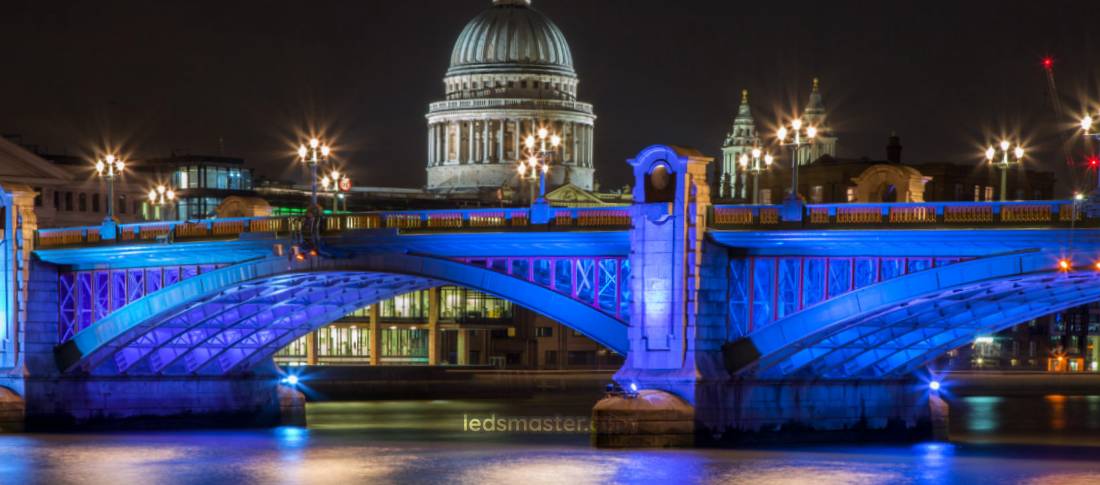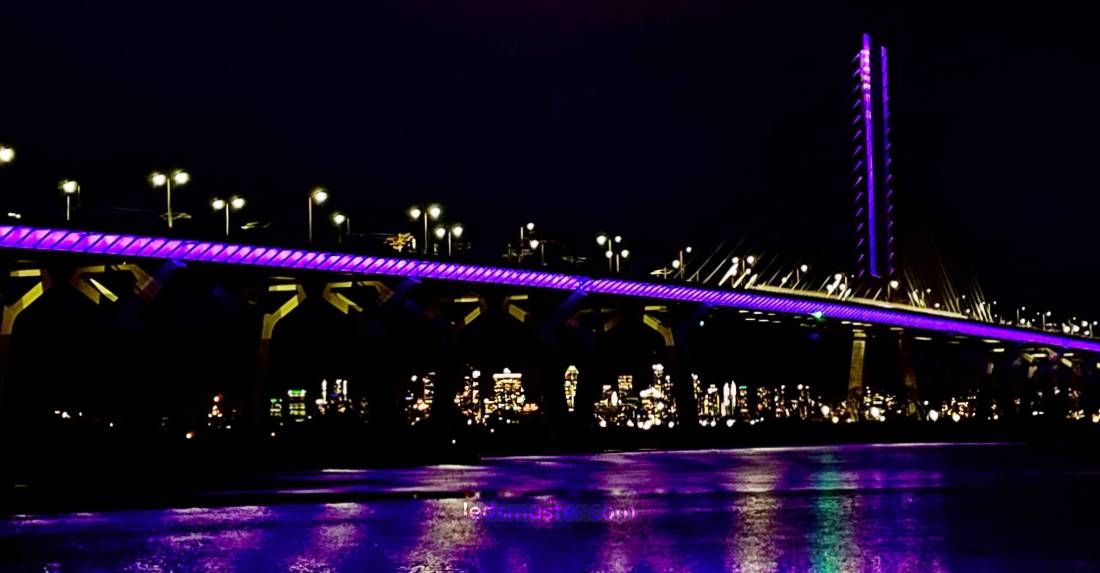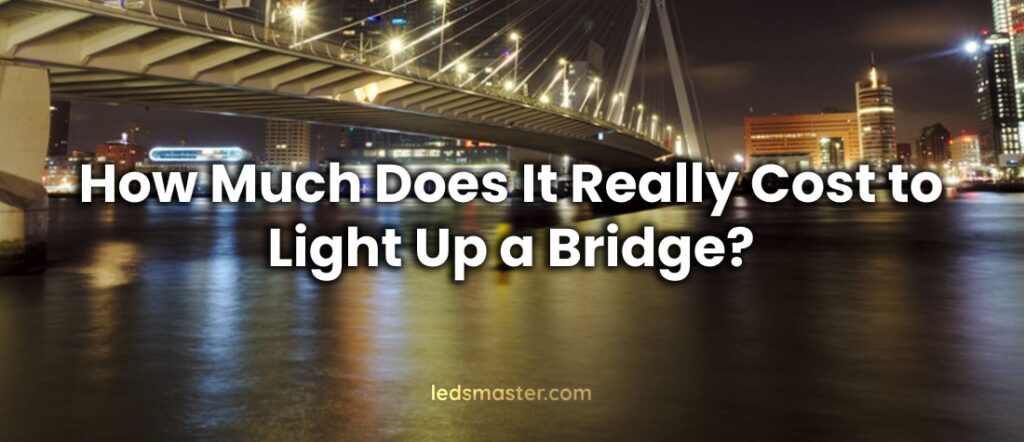Bridge lighting not only enhances the aesthetic appeal of a bridge but also provides functional benefits, such as increasing visibility and ensuring safety for pedestrians and vehicles at night. As with any infrastructure, the cost of installing and maintaining bridge lighting depends on various factors. These include the choice of colors, design complexity, installation methods, maintenance requirements, and repair fees. By understanding these different components, one can gain a clearer view of the overall expenses involved.
| Component | Cost Range |
|---|---|
| Color and Design Choices | |
| Standard White LED Lighting per Fixture | $100 – $200 |
| RGB LED Lighting per Fixture | $300 – $500 |
| RGB Controller | $1,000 – $5,000 |
| Complex Multi-color Designs | 30% – 50% increase in total cost |
| Design Complexity | |
| Basic Floodlight Systems (Small Bridge) | $5,000 – $20,000 |
| Larger Bridge Floodlight Systems | $20,000 – $50,000 |
| Complex Designs (Advanced Lighting) | $100,000 – $500,000 |
| Dynamic Programming (Advanced Systems) | $10,000 – $50,000 |
| Installation Costs | |
| Infrastructure Upgrades | $10,000 – $100,000 |
| Electrical System Upgrades | $20,000 – $200,000 |
| Use of Specialized Equipment (Boats, Cranes) | $10,000 – $50,000 |
| Labor Costs per Hour | $50 – $150 per hour |
| Engineering Costs per Hour | $100 – $250 per hour |
| Labor Costs for Installation | $20,000 – $100,000 |
| Maintenance Costs | |
| Routine Maintenance (Basic Systems) | $5,000 – $20,000 annually |
| Routine Maintenance (Advanced Systems) | $30,000 – $100,000 annually |
| Energy Costs (Annual) | $2,000 – $10,000 annually |
| Environmental Protection and Part Replacement | $10,000 – $30,000 annually |
| Repair Costs | |
| Small Repairs (Minor Issues) | $1,000 – $5,000 |
| Major Repairs (System Overhaul) | $10,000 – $50,000 |
| Labor Costs for Repairs | $50 – $150 per hour |
| Replacement Parts (Basic) | $500 – $5,000 per part |
| Replacement Parts (Complex) | $5,000+ per part |
Table of Contents
ToggleColor and Design Choices: The Impact on Cost
Choosing Colors for Bridge Lighting

One of the first decisions when planning bridge lighting is the color or combination of colors to be used. The selection of color affects both the ambiance and the overall cost. The simplest lighting schemes typically use white or warm light, which can be provided by standard LED or incandescent fixtures. These lights are relatively inexpensive compared to more complex color-changing options. On average, standard white LED lighting can cost around $100 to $200 per fixture.
However, as bridges become more iconic or require a distinctive appearance, color-changing lighting may be integrated into the design. RGB (red, green, blue) LED systems are often used for this purpose, allowing the lighting to shift in hue and intensity. The more advanced the lighting system, the higher the cost due to the technology involved. These systems require specialized controllers and more intricate wiring, driving up both the initial cost of installation and the long-term maintenance costs. RGB LED lights can cost between $300 and $500 per fixture, with controllers adding an extra $1,000 to $5,000 depending on the complexity.
Some bridges opt for multi-color lighting schemes, such as gradients or alternating colors, which can further increase the price. This requires not only more fixtures but also a more sophisticated control system to synchronize the lights. Depending on the complexity of the design, color-changing lighting can raise the total cost by a significant margin. A complex, dynamic RGB lighting system could increase the cost of installation by 30-50% compared to simpler designs.
Design Complexity: A Major Influence on Pricing

Basic Lighting Designs
The design of the lighting system itself plays a large role in determining the overall expenses. Basic lighting designs, such as simple floodlights or wall-mounted lights along the bridge’s supports, are typically less expensive to implement. These designs involve fewer fixtures and less wiring, making installation faster and more affordable. Basic floodlight systems can cost anywhere from $5,000 to $20,000 for a small bridge, with larger systems reaching up to $50,000.
Intricate and Advanced Designs
However, more intricate designs, such as those that illuminate specific architectural features of the bridge or incorporate advanced effects like dynamic lighting, can significantly increase the cost. For example, bridges with archways or suspension cables might require specialized fixtures to highlight these structural elements effectively. This often means additional labor for installation, as well as custom-designed fixtures or mounts. The cost for a complex design could escalate to $100,000 to $500,000, especially when incorporating features like moving lights or synchronized displays.
Further, advanced lighting designs may involve intricate programming to create desired lighting patterns. This adds to both the installation cost and the future maintenance burden, as the system may require regular updates or adjustments to ensure it functions correctly. Advanced programming for these dynamic lighting systems can add $10,000 to $50,000 to the initial setup cost, depending on the scale of the project.
Installation Costs: The Role of Infrastructure and Labor
Infrastructure Requirements
When it comes to installing lighting on a bridge, the infrastructure already in place plays a key role in determining the overall cost. Bridges that were not originally designed to support lighting systems may need additional structural modifications. These modifications can include reinforcing support beams or adding wiring conduits, which adds to the total expense of the project. The cost for infrastructure upgrades can range from $10,000 to $100,000, depending on the bridge’s size and the extent of the required changes.
For more advanced lighting schemes, it might be necessary to install a completely new electrical system, particularly if the bridge does not already have the capacity to handle additional load. These upgrades can be costly and may involve complicated electrical work, especially if the bridge spans a large distance or is located in a difficult-to-access area. The cost of upgrading an electrical system could be anywhere from $20,000 to $200,000.
In some cases, bridges that are located over water may require special equipment for installation, including boats, cranes, or other heavy machinery. This increases both the logistical complexity and cost of the project. The cost of using specialized equipment could add $10,000 to $50,000 or more, depending on the bridge’s location and the complexity of the installation.
Labor Costs
The installation process itself requires specialized labor. Bridge lighting often involves skilled electricians, technicians, and installation teams, all of whom charge varying rates depending on their expertise and the complexity of the project. Labor costs can vary widely depending on the region, but on average, labor for lighting installation can range from $50 to $150 per hour. For a large project, labor costs could range from $20,000 to $100,000 or more.
In addition to the workers themselves, there may be a need for engineers to ensure that the design meets safety standards and regulations, further increasing the cost. Engineering services typically cost $100 to $250 per hour, with total engineering costs ranging from $5,000 to $50,000, depending on the scale of the project.
The location of the bridge can also impact labor costs. Urban bridges with easy access tend to have lower installation costs than those located in remote or hard-to-reach areas. Travel and accommodation expenses for workers may need to be factored in for distant locations, adding an additional layer to the installation fees. For remote locations, travel costs can easily add $10,000 to $50,000 to the overall cost of installation.
Finally, the timing of the installation may influence the cost. If work needs to be done during peak traffic hours or during particular weather conditions, there may be added expenses for securing safety measures, working in adverse conditions, or coordinating with local authorities.

Maintenance Costs: Keeping the Bridge Lit
Routine Maintenance Needs
Once the lighting system is installed, it requires ongoing maintenance to ensure its longevity and proper functionality. Routine maintenance typically includes cleaning the fixtures, inspecting wiring, and ensuring that the lights are functioning correctly. Dust, grime, and weather conditions can all take a toll on lighting fixtures, especially for bridges located in areas with high traffic, pollution, or extreme weather conditions. Regular cleaning and inspections help prevent malfunctions and extend the lifespan of the lighting system. The annual cost for routine maintenance can range from $5,000 to $20,000, depending on the size and complexity of the system.
The cost of routine maintenance largely depends on the size of the bridge and the complexity of the lighting system. Bridges with simple, traditional lighting designs may require less frequent maintenance than those with dynamic, color-changing systems that have more components. More advanced systems may need specialized technicians to perform updates or recalibrate controls, which can raise maintenance costs. For a bridge with advanced RGB lighting, annual maintenance costs could increase to $30,000 to $100,000, particularly if the system needs to be reprogrammed or recalibrated regularly.
Another aspect of maintenance is the electricity consumption of the lighting system. While modern LED lights are energy-efficient, larger, more complex systems may consume more power. Over time, this can lead to increased electricity costs, which should be factored into the long-term maintenance budget. Energy costs for bridge lighting can range from $2,000 to $10,000 annually, depending on the size and energy efficiency of the system.
Environmental Impact
The location and surrounding environment of the bridge also have an impact on maintenance costs. For example, bridges located in coastal areas or areas with heavy industrial activity may face corrosion of metal components or weathering of lighting fixtures. Maintenance teams may need to replace parts more frequently, and special coatings or materials may be required to protect the lights from environmental damage. The added cost for environmental protection and part replacement may be an additional $10,000 to $30,000 annually, depending on the severity of the environmental factors.
Repair Costs: Addressing Damage and Wear
Identifying Common Issues
Despite regular maintenance, it is not uncommon for a bridge lighting system to experience issues that require repair. Common problems include faulty wiring, blown-out bulbs, damaged control systems, or corrosion of metal parts. The cost of repair depends on the nature and extent of the damage, as well as the specific components that need to be replaced.
The age of the lighting system is another factor that influences repair costs. Older lighting systems may require more frequent repairs as their components wear out. In some cases, outdated technology may be difficult to repair or replace, leading to higher costs if entire sections of the system need to be upgraded. The cost of repairs can range from $1,000 for small issues to over $50,000 for more severe damage that requires major parts replacement or system upgrades.
Cost of Labor and Parts
Repairs typically involve labor costs for technicians or electricians, who are responsible for identifying the issue, fixing the problem, and ensuring that the system is functioning properly. Depending on the complexity of the issue, repairs can take anywhere from a few hours to several days, particularly if a specialized part needs to be sourced or if the lighting system spans a large bridge. Labor costs for repairs are typically between $50 and $150 per hour, and repair jobs can cost anywhere from $2,000 to $25,000 depending on the scope of the work.
Parts replacement is another cost to consider when it comes to repairs. While some components, like bulbs or fuses, are relatively inexpensive, more complex parts, such as control panels or specialized fixtures, can be costly. For example, replacement parts for advanced RGB LED systems can range from $500 to $5,000 per fixture or control unit. In some cases, repairs may require custom parts, leading to higher costs.
The longer it takes to repair the system, the higher the overall repair fee. The disruption caused by the need for repairs, such as temporary closures of the bridge for maintenance, can also add to the costs if there are any additional logistical challenges or safety measures involved.
Conclusion
In the end, the total cost of bridge lighting is influenced by a combination of design decisions, infrastructure requirements, installation complexities, ongoing maintenance, and repair needs. Whether opting for a simple, traditional lighting system or an elaborate, dynamic RGB setup, the choice of colors and design complexity can have a significant impact on the overall budget. Installation costs can vary depending on the existing infrastructure and the necessity of additional upgrades or specialized equipment, while ongoing maintenance and repair expenses are influenced by the size of the system, environmental factors, and technological advancements. Properly planning and budgeting for these factors will help ensure that the lighting system is both functional and visually striking while also remaining cost-effective in the long run. Understanding the full scope of these costs is crucial to creating a lighting system that meets the desired aesthetic and performance goals without exceeding financial expectations.

